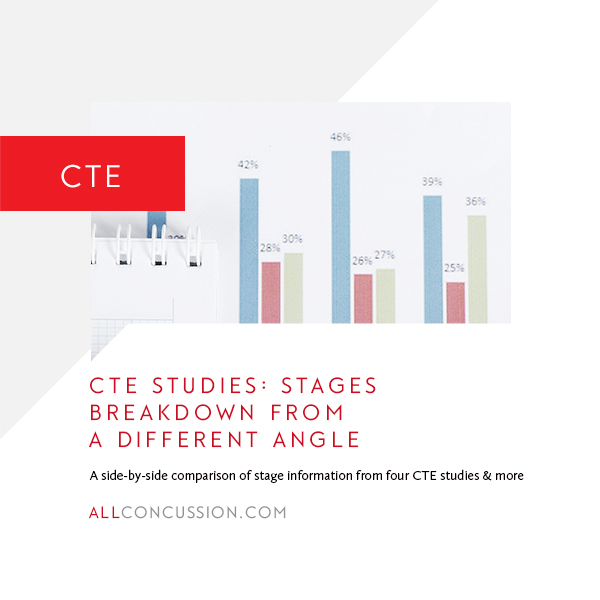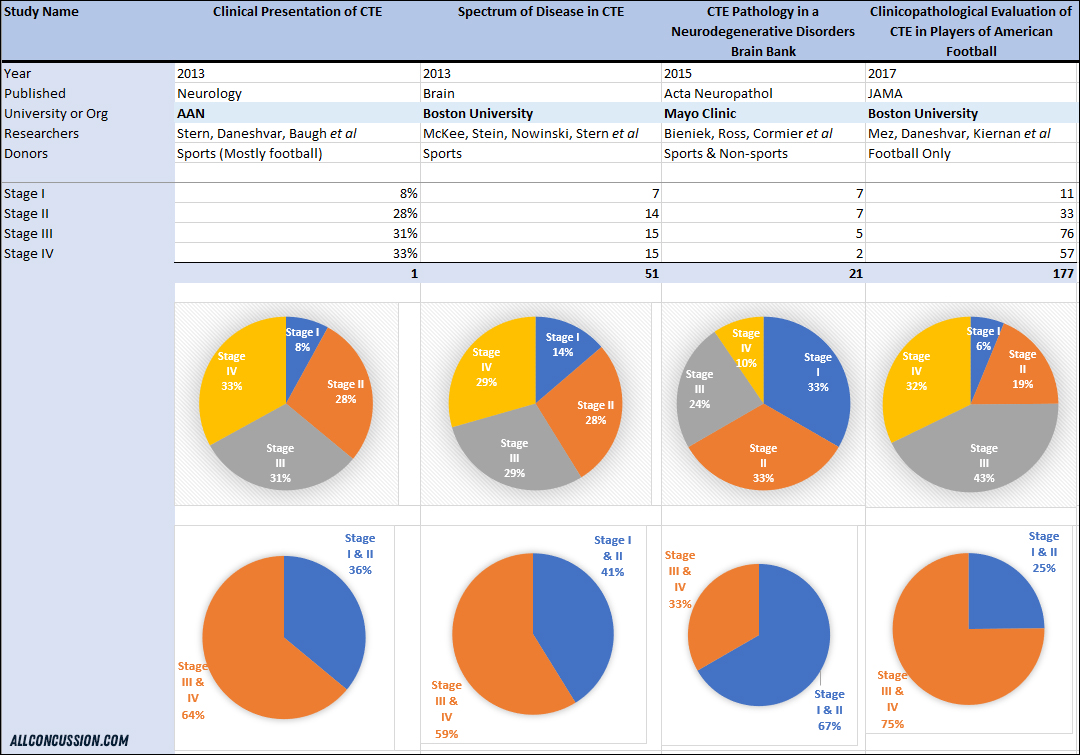
As I went through studies about CTE, I discovered that it’s not very easy to compare apples to apples or find details about mild stages. In this post, I’ll provide my notes and graphics I made during the course of my research. I’m out of time, so am just dropping some screenshots of my notes into this post for your reference. I’ll also note the issues I uncovered with some suggestions for addressing the situation to hopefully prevent such occurrences in the future.
About the Studies
There are four studies for which I have notes. Here is some information about my selection process and why some studies are included:
- I just started with studies from recent years, beginning with 2013.
- I selected studies that seemed most prominent in discussions or news articles, and as references in other studies.
- Most focus on football or sports, but I did find the Mayo Clinic study that included non-sports participants. Given that the whole reason I began looking at CTE was because I saw fear of it creeping into non-sports discussions, I made sure to review the Mayo Clinic study.
- There were several additional studies I would have liked to have included, but the information presented precluded them from inclusion in my review. I’ll include explanations as to why below.
- This was a first batch of studies to review. Given my time constraints, I now will move on to other areas, so this will be the extent of my review.
Studies Included in Notes
These are the studies that are included in my notes:
Clinical Presentation of Chronic Traumatic Encephalopathy
Stern RA, Daneshvar DH, Baugh CM, et al. Clinical presentation of chronic traumatic encephalopathy. Neurology. 2013;81(13):1122–1129. doi:10.1212/WNL.0b013e3182a55f7f
The Spectrum of Disease in CTE
McKee AC, Stern RA, Nowinski CJ, et al. The spectrum of disease in chronic traumatic encephalopathy [published correction appears in Brain. 2013 Oct;136(Pt 10):e255]. Brain. 2012;136(Pt 1):43–64. doi:10.1093/brain/aws307
Chronic Traumatic Encephalopathy Pathology in a Neurodegenerative Disorders Brain Bank
Bieniek KF, Ross OA, Cormier KA, et al. Chronic traumatic encephalopathy pathology in a neurodegenerative disorders brain bank. Acta Neuropathol. 2015;130(6):877–889. doi:10.1007/s00401-015-1502-4
Clinicopathological Evaluation of CTE in Players of American Football
Mez J, Daneshvar DH, Kiernan PT, et al. Clinicopathological Evaluation of Chronic Traumatic Encephalopathy in Players of American Football. JAMA. 2017;318(4):360–370. doi:10.1001/jama.2017.8334
Studies Excluded From Notes
These are the studies that I hoped to include in my analysis, but was unable to.
Age of First Exposure to Tackle Football and Chronic Traumatic Encephalopathy
For the public, this is behind a paywall. The current cost as of 4/7/19 is $7 for 48-hour access or $42 to purchase a PDF to download. Given the debates raging over the future of youth football and ongoing moves to ban it in multiple states, I think this study should be changed as soon as possible so it is freely available to all as open access.
CTE in College Football Players
In the midst of my review of studies, the Concussion Legacy Foundation released information about football players at different colleges who were found to have CTE. Unfortunately, there was no breakdown by stage, so it didn’t fit in my review.
Number of Study Donors With and Without CTE
The first topic of focus for me was to determine the numbers of study donors found to have had CTE versus those that did not. I’ve noticed in some news reports that at times, only a subset of donor numbers are discussed in news articles. I felt it was important to look at overall numbers for each study. Here are the results.

Stages of CTE in Study Donors
Next on my list was to review incidence of CTE broken out by phase. In this graphic, you can see a breakout by phase as well as a grouping into Stage I and II, and Stage III and IV.
The four-phase breakout was more difficult to compare from study to study. It’s a problem which can easily be avoided in the future if researchers, peer reviewers, and journal editors are willing to make a few simple changes. If you follow me in social media, you may recall a few months back when I continually asked for a breakout by stages for studies. This is why. I was in the midst of trying to analyze and compare studies, and found it difficult because published studies don’t always include stage breakdowns.
Note: For the Mayo Clinic study, keep in mind that the count for CTE is a small percentage of the overall study. There were 264 samples studied overall, and 21 found to have CTE.
Solution 1: In future studies, always include the actual numbers of donor samples for each of all four stages.
Solution 2: In future studies, always include actual numbers and not just percentages as occurred in the 2013 study.
Solution 3: Write an addendum for studies such as the 2013 study to provide the missing information.

BU – JAMA Football Study: Additional Information
There’s a table in the BU – JAMA study which contains two types of information (it’s Figure 3 in the study). (Note 4/30/20: It’s a heat map.) When you look at the table, you can see values for each table cell as well as a color. I pulled out the table values and created a graph from them, which I’ve included here. The graph is more visual and helps show the differences in levels, I think, and I like to see chart comparisons. I suggest that you also review the source figure in the study to also review the color chart. You’ll see in the color chart in Figure 3 in the study that for Stage I, most are in the yellow range, which is lower for the number of neurofibrillary tangles (NFTs).

Here is the breakdown for different levels also included in the study. Most focus in news articles about the study has been on the NFL players. However, there were also some donors who played football but stopped playing earlier in life. The highest number of samples were from those that played in the NFL. If you’d like more information, I suggest taking the time to read the study as well as the additional information provided with it.

Note: I haven’t come across studies focusing more on those that played football as a youth up through high school but not afterward. As I noted in item 4 in my 7 Surprising Facts About CTE post, there are CTE studies underway, but they focus on college football players and beyond. I don’t know if there are any studies of players who participated in football through high school only (or earlier) currently in the pipeline. That’s something to watch for.
Summary
This post only looks at four CTE studies and should not be considered to represent all research or predict incidence of CTE. There are many other CTE studies, so I suggest that you take some time to find and review them. There is often additional information not included in articles. Read through the materials and tables and see what the data tells you. I’ve had difficulty finding information about mild stages. My hope is that all studies start including a breakout into all four stages and no longer group them into two categories or just list percentages. Also, these are just a few notes from the four studies. I encourage you to review the studies yourself (links are earlier in this post) because there’s more information in them as well.
Two notable studies were also released since I reviewed the studies mentioned in this post. They’re both worth a look as well. One is the study that identified CTE as being unique and different than Alzheimer’s on a molecular level. The other reviewed over 300 non-sports donor samples and found no instance of CTE.
Keep researching and reading!
